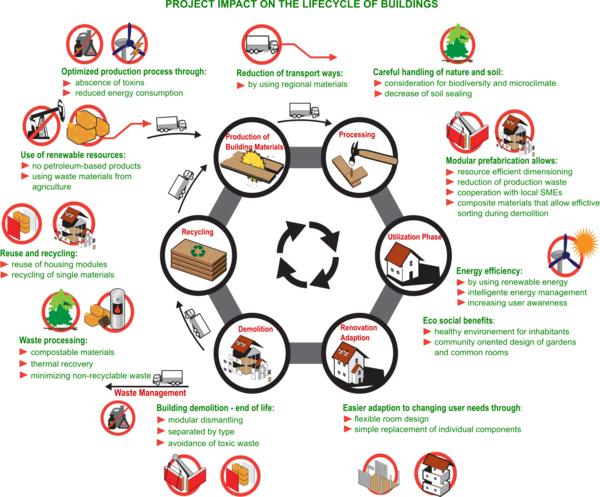Project goals
The overall objective of the EU LIFE+ LCH is to demonstrate innovative building concepts that significantly reduce CO2 emissions, mitigate climate change and contain a minimum of grey energy over their entire life cycle. The ultimate goal is to design and build prototypes for carbon-neutral and “LIFE cycle”-oriented residential buildings and make energy-efficient settlements the standard of tomorrow in line with the EU 2020 objectives.
To this end, a high resource and energy-efficient building compound will be built in the region around St. Pölten, Lower Austria, consisting of some residential units and a community center as straw bale buildings of different innovative construction types (load-bearing and pre-fabricated modular construction) and are supplied through a highly innovative energy-supply system.
The demonstration objects in the project are CO2-neutral over the entire life cycle. CO2 emissions and waste of resources are significantly reduced over the entire life cycle:
Towards a highly efficient and demand-oriented system, thermal energy is utilized to the maximum. All buildings can be run entirely without fossil energy resources. Thermal energy services of household devices like a washing machine or a dishwasher are running on thermal energy instead of electric energy, making the system highly efficient without conversion losses. Even the operation of refrigerators and cooking devices with thermal energy will be demonstrated.
Highly energy-efficient and sustainable building materials are used: straw bales are regional renewable resources with a very low "grey energy" (100 times less than conventional insulation materials), store CO2 and provide high thermal insulation. Building components of the village will be produced in collaboration by local SMEs (Small and Medium Enterprises) that are organized in an efficient way.
The whole building process and results are monitored and prepared for knowledge transfer and dissemination, including: guided tours, an opening event, trial living in the residential units to test and monitor the energy supply system and to involve stakeholders into evaluation and dissemination of the applied technologies and building concepts; use of the community center as a public information and exhibition area; participation in EU conferences and publishing of scientific articles as well as press releases.

